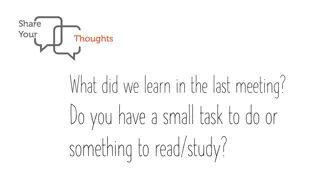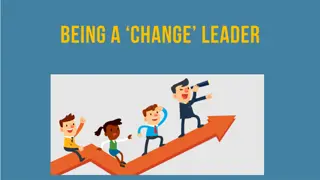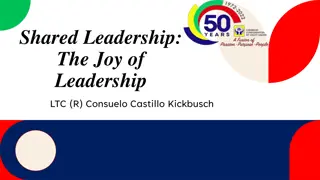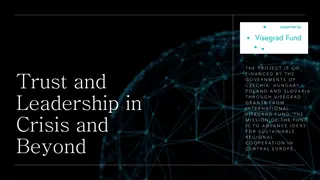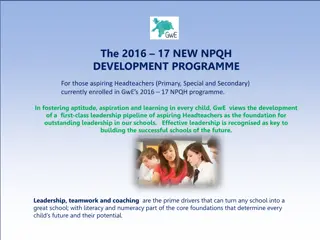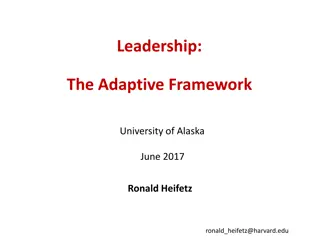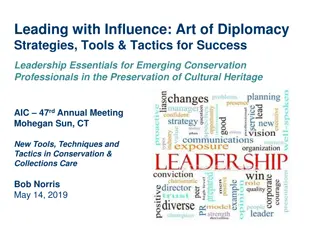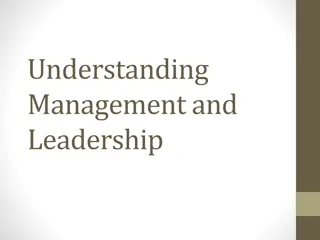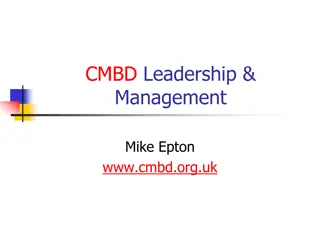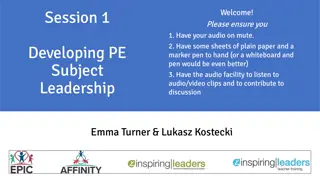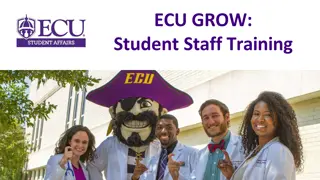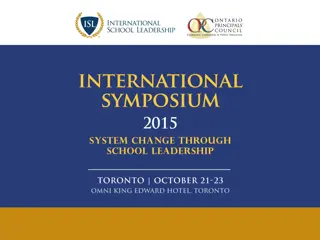Understanding Effective Leadership Communication Strategies
Leaders rely on effective communication to share their vision, motivate teams, build trust, and achieve goals. This involves feedback, encoding and decoding messages, management versus leadership communication approaches, purpose-driven communication, and the importance of sharing open and honest information across all levels of an organization.
- Leadership communication
- Effective communication strategies
- Feedback in leadership
- Encoding and decoding
- Organizational communication
Download Presentation

Please find below an Image/Link to download the presentation.
The content on the website is provided AS IS for your information and personal use only. It may not be sold, licensed, or shared on other websites without obtaining consent from the author. Download presentation by click this link. If you encounter any issues during the download, it is possible that the publisher has removed the file from their server.
E N D
Presentation Transcript
What is involved in communication? Leaders communicate to share the vision with others, inspire and motivate them to strive toward the vision, and build the values and trust that enable effective working relationships and goal accomplishment. (Daft, 2008, p. 259)
Technology in communication: Good & Bad? Missing Affect outcomes? People as whole people? Personal? Quality of communication? Lazy communication?
As followers we like to give feedback so why when we are leaders do we no longer want to hear feedback? Why don t coaches ask for feedback? Feedback from assistants? Top-down paradigms vs. inverted paradigms.
Encoding & Decoding Individual differences Knowledge. Values. Attitudes. Background. Goal: Transfer information WITH shared meaning.
Management Communication: directing the traffic of communication. Collecting pieces of the puzzle and determining who gets to see which pieces at which time. Leadership Communication: using the whole person approach and ensuring everyone can see the vision (the picture on the box of the puzzle) while striving to promote upward communication links. High use of purpose, ultimate vision and stories / metaphors.
Purpose Directed Direct attention to vision/values, desired outcomes; use persuasion Leader as Strategic Conversation Open climate Listening Discernment Dialogue Communication Champion Internal and external sources Methods Use rich channels Stories and metaphors Informal communication
Sharing all types of communication across job descriptions (horizontal) and hierarchies (vertical). Surveys show employees want good and bad information. Why don t we, as leaders, give open and honest information? Ownership in the text is akin to autonomy as we discussed in Motivation & Empowerment.
An open climate is essential for cascading vision, and cascading is essential because: Natural Law 1: You Get What You talk about A vision must have ample air time in an organization. A vision must be shared and practiced by leaders at every opportunity. Natural Law 2: The Climate of an Organization is a Reflection of the Leader A leader who doesn t embody the vision and values doesn t have an organization that does. Natural Law 3: You Can t Walk Faster Than One Step at a Time A vision is neither understood nor accepted overnight. Communicating must be built into continuous, daily interaction so that over time followers will internalize it. 9
Conditioned to have right answers and only give right answers. Problems need answers leaders must have and provide the right answer. Think of school Ripple effect of a leader asking questions is ? Leader centered vs. follower-centered. Think about categories of leadership
Most folks are thinking of what to say next while they should be listening to what is actually being said. Average retention rates of auditory information is around 25%. Can listening be draining?
Keys Poor Listener Good Listener 1. Listen actively Is passive, laid back Asks questions; paraphrases what is said 2. Find areas of interest Tunes out dry subjects Looks for opportunities, new learning 3. Resist distractions Is easily distracted Fights distractions; tolerates bad habits; knows how to concentrate Challenges, anticipates, summarizes; listens between lines to tone of voice Nods; shows interest, positive feedback 4. Capitalize on the fact that thought is faster than speech Tends to daydream with slow speakers 5. Be responsive Is minimally involved
Keys Poor Listener Good Listener 6. Judge content, not delivery Tunes out if delivery is poor Judges content; skips over delivery errors Has preconceptions; argues Does not judge until comprehension is complete Listens to central themes 7. Hold one s fire 8. Listen for ideas Listens for facts 9. Work at listening No energy output; faked attention Works hard; exhibits active body state, eye contact Uses heavier material as exercise for the mind Resists difficult material in favor of light, recreational material 10. Exercise one s mind
Utilizing nonverbal and situational cues not verbalized during communication. We are taught to be PC and speak words that are less likely to offend. Most of us aren t taught how to behave while we are speaking. Remember only 25% of our words are retained! People watching full time and not as a boredom quelling activity.
Finding that shared meaning in the message and building upon that base layer by layer with a lack of right vs. wrong and judgments. Discussions are taught and encouraged. Debates, position statements, right vs. wrong. Sports are huge for this. Sometimes called bar room debates . Best 3rd baseman of all-time is ?
Conversation Lack of understanding, disagreement, divergent points of view, evaluate others Dialogue Discussion Reveal feelings Explore assumptions Suspend convictions Build common ground State positions Advocate convictions Convince others Build oppositions Result Result Short-term resolution Agreement by logic Opposition beaten down Mind-sets held onto Long-term, innovative solutions Unified group Shared meaning Transformed mind-sets
Establish credibility: knowledge, expertise, relationships, track-record and demonstrating a we mentality. Build goals on common ground: show folks how what they do impacts the overall picture and that the overall picture benefits them. Make your position compelling to others: use emotion to your advantage through symbols, metaphors and stories. Connect emotionally: EQ and adapt to the situation to ensure followers are ready to listen.
Electronic mail, IM, Web, intranet Face-to-face verbal Formal report Disadvantages Impersonal One-way Slow feedback Advantages Personal Two-way Fast feedback High channel richness Low channel richness Advantages Provides record Premeditated Easily disseminated Disadvantages No record Spontaneous Dissemination hard Memos, letters Telephone
The ability to handle multiple cues simultaneously. The ability to facilitate rapid, two-way feedback. The ability to establish a personal focus for the communication.
The goal is to further emphasize the emotional connection. Must consider the communication process still. Information must be congruent with listeners abilities, knowledge base and/or experiences. Select stories carefully as listeners only remember 25% anyway and the story is more likely to be in that 25% than the remainder of your verbalized information.
Part is the nonverbal communication (weighted higher than verbal) and the goal as the leader is to have our verbal and nonverbal match to enhance our credibility and further emotional connections. Part is the setting. Informal conversations can dramatically influence the openness of an environment and the transfer of information. Think school





